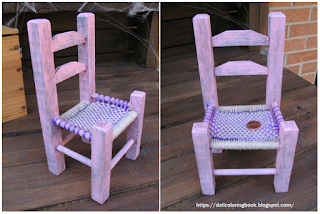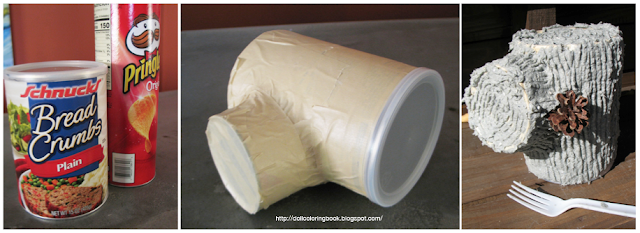 |
| Left, Historic Trinity Church School for Dolls, founded in 1903. Right, A view from the West during a school picnic |
This historic doll school was founded that there might be a place, easily accessible to the dolls of any child's collection where they will have a thorough education and a happy home life. Here dolls are surrounded by refining influences and they can be physically, intellectually and spiritually trained if their child owners so choose.
As the cost of living in Dollville is less than in most places, it has been possible to make the fees more moderate than those of real child schools, and there are, comparatively speaking, no outside expenses.
Miss Carroll, the Lady Principal Doll, has had much experience in work of this kind, having been for many years Senior Mistress at Trinity Church School for Dolls.
The place chosen could not be more appropriate, a handsome and well-built building, situated upon the prettiest street in Dollville, and surrounded by beautiful grounds two and a half acres in extent.
To the original building a large three-story addition has been made, which contains the chapel, art-room, dining-room, room for domestic science, infirmary, and sleeping apartments.
The rooms are large and well-ventilated, the class-rooms bright and airy.
As the cost of living in Dollville is less than in most places, it has been possible to make the fees more moderate than those of real child schools, and there are, comparatively speaking, no outside expenses.
Miss Carroll, the Lady Principal Doll, has had much experience in work of this kind, having been for many years Senior Mistress at Trinity Church School for Dolls.
The place chosen could not be more appropriate, a handsome and well-built building, situated upon the prettiest street in Dollville, and surrounded by beautiful grounds two and a half acres in extent.
To the original building a large three-story addition has been made, which contains the chapel, art-room, dining-room, room for domestic science, infirmary, and sleeping apartments.
The rooms are large and well-ventilated, the class-rooms bright and airy.
The recreation grounds are extensive: tennis, basket-ball, croquet, swings, all have their place, and out-door exercise is encouraged as much as possible.
There is a picturesque artificial lake in the grounds, shown in the picture below, left.
There is also a fine orchard, a vegetable garden, and a poultry yard, thus combining the advantages of country with city life.
The work done during the school year is always very satisfactory, and a decided improvement in our doll pupils is exceptionally noticeable. Universal satisfaction has often been expressed by their young owners.
It is our wish to create in dolls a love for their work, and to arouse an interest in learning which will not pass away with their school days.
A series of recitals will been given by the dolls of both musical and dance talent. In the past and they have been enjoyable as well as most helpful in overcoming the nervousness and self-consciousness of our doll students.
An excellent course of University Extension Lectures was held at our school during the winter break, and more recently a most interesting and instructive course upon Practical Home Nursing. Courses similar to these will be offered again during the next semester.
 |
| Left, Historic View From The South During Spring Semester. Right, Historic Winter View From The North. |
- The Alphabet and Spelling Posts
- Church Catechism Index
- Nature-Studies Index
- The History of People, Places and Things Associated With Holidays: Index
- Further Studies in Topics Associated With Literary Dolls: Index
 | |
| Crafts features from our school index include a graduation cap, an art supply cabinet, cheerleader pom-poms and a restored school desk for doll play. | |
 |
| In 2023 our private school students will replace the school uniforms with street attire! See what our dolls are wearing... |
- Printable Student IDs for Your Doll and You! - Now your dolls can have student doll IDs for Trinity Church School and so can you!
- Trinity Church School: Doll Enrollment - custom and original doll characters at Trinity Christian Academy for dolls: Sophie Xu, Chavonne Richards...
- About Me Name Game - for new dolls in pretend classrooms
- School Uniforms for Dolls - The required school uniform for our dolls at their school...
- School Supplies for Dolls Entering 4th-7th Grade
- Church Interior for Doll Photography - This lovely church interior is by photographer Simon Bowen.
- Play the About Me Name Game on your doll's first day of school - a printable About Me name tag for doll and her friends
- Make Doll School Cafeteria Lunch Trays - DIY lunch tray for the pretend school cafeteria
- A Doll Art Supply Cabinet With Drawers - All the supplies your dolls will need to become a student artist...
- An Old-Fashioned School Desk for A Doll - A school desk made by our next-door-neighbor.
- Doll Sized Spelling Printables - 1841 - How dolls and school children learned their ABCs 150 years ago.
- Doll Gingerbread Horn Book Craft - Make a delicious edible horn book craft for your historic American Girl Dolls. Edible horn books were rewards for kids who learned their alphabet successfully during the Colonial Era.
- The Horn Book in America - Education for children in Early America.
- Restoring An 18 inch Doll's Desk - Restore a desk, make new drawers and writing accessories.
- DIY Clamshell Laptop for Your Favorite Doll - Every doll needs a laptop for school and homework! This version is made using cardboard and clipart.
- Printable Food Group Posters for The Doll Classroom - free posters for your doll's health class.
- Restoring An 18 inch Doll's Desk - replacing missing drawers, crafting a few decorative and useful desk top supplies
- Print Out and Color In An AG Doll Sized, Doll Coloring Book - doll coloring for doll's to color!
- 18" Doll Sized Pencil Case Craft - A beginner sewing project for young students; now your doll can carry her toothpick pencils neatly without loosing them inside her backpack!
- DIY a Doll's Megaphone - for school spirit, cheerleaders, and pep rallies...
- DIY Simple Doll Cheerleader Pom-poms - in our church school colors but you can make them any color you like!
- Craft a travel pillow for your doll - just in case she falls asleep in the car while going to school!
- Craft a graduation cap for your doll student - Every doll loves to celebrate her academic progress and you can make paper graduation caps for all of them!
- DIY a doll size, freestanding water cooler... - made using recycled materials only!
- DIY Office Supply for A Doll's Desk - Crafts for pencils, pink erasers, journals, paper weights and tape dispenser!
- The Annual Valentine Mailbox Competition - Every year participating students enter a mailbox contest with award ribbons, party games, and Valentines of course!
- Vintage Classroom Clipart - decorate a doll classroom, yearbook, supply cabinet etc...
- Craft Cute Clip Boards for Doll School! - Decorate these with your favorite stickers too.
- Currier & Ives Prints for The Dollhouse - "God Bless Our School" antique print from late 1800s, for an old-fashioned classroom!
- School Desks for 18" Dolls - all kinds
- Flossie Plays School with Her Friends - read her letter with your eyes, write her story with your own words
- Cut a foam hand mit for your doll's school spirit! - make them in your doll's school colors...
 |
| school days silhouette |
Doll Fan Video About School Days:
- Awesome Academy OG Stop Motion - Our Generation
- How to be safe at school by AG mini Makers
- American Girl Doll School Classroom - Packing School Bags and Lunches
- DIY AG Doll School Classroom With Locker, Desk, & Accessries by CC and Lulu
- Cecee's Pre-Presentation Jitters - Join an Our Generation Doll classroom for a history presentation
- Cleaning up American Girl Doll school lockers on the last day of school! by agoverseasfan
Doll Fan Back To School Shopping:







































